Ever wondered how the hiring teams of the world’s most famous companies recruit the best talent and make their mark as top employers?
From Netflix’s culture-centric recruitment to Elon Musk’s skill-based hiring spree, we’re dishing out the inside scoop on the strategies that have these companies sourcing the best talent.
Let’s take a look at what goes on behind the scenes in the world’s most well-known employers’ hiring boardrooms.
Heads up: You can skip to your preferred company as we’re going to get into the nitty-gritty.
1. How has Netflix fostered a culture of recruitment as its hiring strategy?
Netflix has created a hiring culture that’s not just about filling jobs but finding people who truly believe in the company’s mission and values.
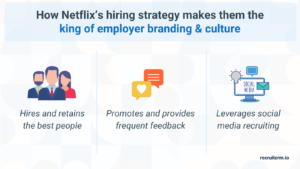
The book “No Rules Rules” sheds light on specific insights that reveal what makes Netflix’s hiring strategy unique.
Let’s take a closer look at how they’ve done this:
a. Hire and keep only the best employees
Netflix’s hiring principle revolves around hiring and retaining ONLY the best employees.
They learned a valuable lesson during the aftermath of the 2001 dot-com crash when they had to lay off a significant portion of their workforce.
Surprisingly, this change didn’t dampen the morale.
Instead, it ignited a surge in energy and productivity among the remaining staff.
The key insight was that by eliminating less-than-stellar employees, Netflix significantly increased its ‘talent density’–the ratio of top talent to the overall workforce. This shift created an environment where high-performing employees thrived.
These top performers were drawn to Netflix for several reasons:
- Learning and improvement: Being surrounded by other top performers allowed them to learn and grow continuously.
- Motivation and satisfaction: The presence of fellow high achievers motivated them to produce high-quality work, boosting individual motivation and satisfaction.
Netflix believes that a team of highly talented people pushes everyone’s performance up!
b. Promote candid and frequent feedback
At Netflix, promoting candid, frequent feedback is central to their culture. The realization came when they had a team of talented, collaborative employees.
Embracing candid feedback led to several positive outcomes:
- Performance enhancement: The exchange of candid feedback helped individuals understand how to improve, resulting in improved performance at the individual and company-wide levels.
- Open communication: Direct feedback fostered open communication, reducing misunderstandings and enhancing teamwork.
- Co-accountability: Netflix created an atmosphere of co-accountability, where team members held each other accountable for their actions, not just relying on managers to correct behavior.
In fact, providing and receiving feedback became so integral to Netflix’s office culture that not speaking up was seen as an act of disloyalty, hindering the company’s improvement.
c. Leveraging social media for streamlined recruitment
Being the head player in the digital streaming space, Netflix’s recruitment playbook is incomplete without social media.
And what better social platform than LinkedIn?
The company leverages LinkedIn to reach potential candidates and utilizes advanced tools, including an applicant tracking system, for a seamless screening process.
Social recruiting saves time and ensures that the recruitment team can concentrate on finding the perfect match for each role.
You might also like: Top 7 LinkedIn recruiter certification courses to supercharge your skills
2. Apple’s 3 Es for hiring the best candidates
Apple recruits 100,000 employees every year. But have you ever stopped to wonder how the company does this?
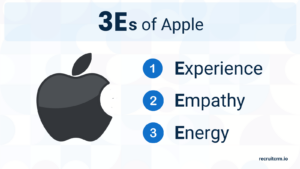
While the 3 Es offer a baseline, a dive into Tim Cook’s interview on CBS’ 60 Minutes, by Carmine Gallo for Forbes, uncovers a more profound understanding of Apple’s hiring criteria.
Here’s what Tim Cook has to say about the 3 Es behind Apple’s hiring strategy–
a. Expertise: Beyond conventional qualifications
It’s not just about having skills or a degree from a prestigious institution.
Apple, as Tim Cook emphasized in his interview, looks for individuals who work with passion and idealism.
A recruiting manager from Apple, in the Forbes analysis, noted, “We’ve learned to value a magnetic personality just as much as proficiency.”
b. Empathy: Crafting user-centric experiences
Next on the list is “empathy.”
You see, Apple believes in creating products that resonate with people that make a difference in their lives.
And to do that, they believe in building teams that genuinely understands and cares about the users.
It’s about being able to see things from the user’s perspective and using that insight to create something truly special.
c. Energy: A relentless pursuit of excellence
While energy is about passion, Apple seeks workers who do not simply accept the status quo.
Referring back to Steve Jobs’ iconic ‘think different’ ad campaign, Tim Cook reiterated this quality as seeking those “crazy enough to think they can change the world.”
You might also like: The role of work-life balance in hiring: Tips for incorporating flexibility in your process
Additional layers to Apple’s hiring strategy
- Resilience over rejection: One of the striking qualities Apple seeks is a candidate’s ability to not take ‘no’ for an answer.
This trait is so integral that recruiters often ask, “Can this person have gone toe-to-toe with Steve Jobs?” as mentioned by Cook in his interview with CBS.
- Hunger for better: Apple values individuals who inherently feel things could be improved. They aren’t looking for those who have all the answers, but rather those driven to relentlessly seek them.
- Defying impossibilities: Cook’s conversation highlighted the value Apple places on those who can’t be told something is impossible. Apple’s DNA cherishes those who work doubly hard to prove their critics wrong, a trait evident from the early days of Apple retail’s conception.
So, when Apple taps into these principles, they’re not just hiring folks.
They’re bringing together a team of spirited innovators whose energy you can feel in every Apple product.
And if you caught that episode on CBS’ 60 Minutes, you’d know Apple isn’t just playing the usual hiring game–they’re shaping a team that’s truly game-changing!
3. How Google uses “quiet hiring” to recruit top talent
Before we delve into Google’s hiring strategy, let’s understand why there’s so much buzz around quiet hiring and what this means for recruiters.
Quiet hiring is a strategy where companies find new skills without necessarily hiring new full-time employees.
This could mean giving existing employees new roles, offering them opportunities to learn new skills, or even bringing temporary workers to handle specific tasks.
It’s a flexible approach that helps companies adapt quickly to their business needs.
But how is Google incorporating it?
Here’s a glimpse–
a. Making the most of existing talent
Google has long believed in the value of its existing team.
Instead of constantly hunting for external talent, they prioritize the goldmine they already possess.
By reassessing the strengths and potential of their current employees, Google can shift them into roles where they can truly flourish.
It’s a two-pronged win: employees feel valued and get the opportunity to shine, while the company benefits from maximized productivity.
b. Empowering skill development
One of Google’s standout features is its commitment to employee growth.
Ever heard of their “20% Project“?
It’s an innovative program allowing Googlers to spend a fifth of their time on passion projects outside their primary roles.
This for sure fosters creativity and skill development among employees.
And here’s the most fascinating bit.
This “20% Project” was the catalyst behind the creation of one of Google’s most popular services – Gmail!
A Forbes article even highlighted the “Grow with Google” initiative as a testament to Google’s commitment to both internal and external skill development.
Not only does this help existing staff to upskill and grow into new roles, but it also helps fill skills gaps–a major hiring challenge today.
c. The temp talent strategy
Sometimes, businesses requires a bit more manpower, and that’s where temporary or gig workers come in.
Google hires temporary staff to address specific needs, allowing them to maintain a flexible and adaptive workforce.
Undoubtedly, Google’s successful implementation of this strategy showcases its forward-thinking approach to maintaining a competitive edge in the industry.
It certainly gives food for thought for those looking to revamp their recruitment strategies, don’t you think?
You might also like: ‘Quiet quitting’ explained: Here’s what recruiters need to know about this buzzword
4. Top 3 lessons to learn from Microsoft’s social recruiting strategies
It’s no secret that Microsoft has been a trailblazer in many areas, and its hiring strategies are no exception.
But what can we actually learn from its recruitment strategy?
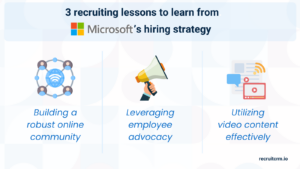
Now, let’s look at them more deeply.
a. Building a robust online community
Microsoft doesn’t just use social platforms to post job vacancies; they create spaces where professionals can connect, learn, and grow together.
This strategy does more than just attract talent. It fosters an ecosystem of learning, mutual growth, and collaboration, positioning the company as a leader in thought and action.
In fact, Microsoft isn’t content with just posting job openings on its career site; they’ve taken their game to Twitter too.
Their recruitment-specific Twitter handle, @MicrosoftJobs, not only showcases “hot jobs” but also brilliantly encapsulates the company’s essence.
What stands out is their authentic engagement with the Twitter community.
On any given day, you might stumble upon light-hearted and humorous snapshots from their office–giving a tangible feel of the company’s culture.
This strategy is more than mere branding.
By blending job opportunities with candid office moments, Microsoft ensures they’re not just attracting potential candidates but also giving them a genuine taste of THE MICROSOFT EXPERIENCE.
b. Leveraging employee advocacy
Ever seen a Microsoft employee share their work journey on LinkedIn or Twitter?
That’s no accident.
Microsoft taps into the invaluable resource of employee experiences.
Encouraging their staff to become brand ambassadors, sharing stories, challenges, and triumphs, they’re offering an authentic window into the company’s culture.
This isn’t just smart employer branding; it’s a transparent invitation showcasing the real Microsoft experience, resonating deeply with potential hires who are seeking genuine insights.
It’s a genuine and transparent way to showcase what working at Microsoft is really like, straight from the people who know it best.
c. Utilizing video content effectively
Lastly, let’s not overlook the impact of video content.
Microsoft has embraced the power of incorporating video in its recruitment strategy, using it to give a real and tangible glimpse into life at the office.
From showcasing day-in-the-life videos to sharing insights from leadership, video content allows them to connect with potential candidates on a deeper level, making the recruitment process more personal and engaging.
Also read: Change your recruiting game with one-way video interviews in 2023
5. Is “stickiness of hires” working for Adobe?
Ever heard the term “stickiness of hires”?
It’s all about ensuring new hires don’t just come aboard, but they stay engaged, productive, and, well, stick around. And guess who’s acing this game? Yep, you guessed it–Adobe.
Adobe has revamped its recruitment process to not just attract top talent, but also ensure they thrive once they’re hired.
They’re not just playing the short-term hiring game. Their hiring team ensure that new hires are in it for the long haul.
Jeff Vijungco, vice president of global talent at Adobe says: “Recruiters are sales-oriented, and measure their success by things like time-to-fill a role, but once the job is filled they quickly move on to the next one. That created a gap between hiring and onboarding. To close it, we added a new performance metric for recruiters around “stickiness of hire.”
Here’s how Adobe achieves this:
a. Crafting the perfect candidate experience
Adobe’s strategy kicks off even before the hiring does. From the get-go, they’re keen on offering a smooth, transparent, and an engaging candidate experience.
It’s not just about getting talent in the door; it’s about ensuring they feel valued right from their first interaction. And this, my friends, sets the stage for long-term engagement.
b. A focus on retention from day one
Once the new hire is in, Adobe’s work isn’t done.
Through structured onboarding processes and continuous learning opportunities, Adobe ensures that their new hires are equipped with the tools, knowledge, and resources to not just do their job, but excel at it.
Adobe recognizes that an informed and empowered employee is more likely to be a satisfied (and sticky!) one.
c. The real question: Is it working?
Short answer? Absolutely!
Adobe’s revamped recruitment strategy has led to more engaged, productive, and long-term employees. They’ve effectively managed to reduce turnover, ensuring that their investment in talent truly pays off.
So, next time you’re pondering over recruitment strategies and how to make hires stick, maybe take a leaf out of Adobe’s book.
6. Amazon’s secrets to high-volume recruiting
Amazon recruits over 15,00,000 individuals worldwide yearly–high volume recruiting, INDEED!
But what are their secrets to this number?
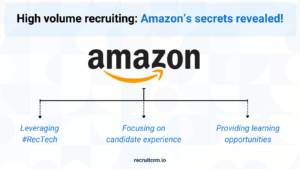
1. Leveraging #RecTech to its fullest
Amazon doesn’t just use any applicant tracking system.
Their sophisticated AI recruitment systems, as reported by several tech journals, prioritize not just skill matching but also predictive analytics–assessing which candidates are more likely to accept offers or stay long-term.
Bezos has been quoted saying, “It’s not an experiment if you know it’s going to work.”
This sentiment is clear in Amazon’s bold use of technology in recruitment, where they are not afraid to push boundaries to refine their process.
2. Focusing on candidate experience
From the moment a candidate applies, they are treated with utmost respect and transparency at Amazon.
The company believes in keeping the candidates informed at every stage, fostering a positive and respectful engagement that leaves a lasting impression.
Amazon candidates, whether successful or not, often receive detailed feedback.
This respect towards every potential employee strengthens their employer brand massively.
Bezos’s mantra of “customer obsession” isn’t limited to Amazon’s shoppers.
They treat their candidates as customers, ensuring every interaction adds value and leaves a lasting impression.
3. Providing training and development opportunities
Amazon places a significant emphasis on training and development.
New hires are not just recruited but nurtured to grow within the company.
Amazon invests in its employees, offering them opportunities to learn and develop their skills, fostering a culture where individuals can thrive and build rewarding careers.
Here are a few ways how Amazon embodies this:
Amazon University: Yes, Amazon has its own ‘university‘–an extensive array of training programs designed to hone various skills, from leadership to coding.
They even have a list of open positions ranging from internships to entry level jobs.
They understand that the best way to predict the future is to enable their employees to build it.
Career choice program: As reported by CNN, Amazon has a program where they pre-pay 95% of tuition for employees to take up in-demand courses, emphasizing their commitment to employee growth.
Bezos, in his annual letters and addresses, has consistently stressed the importance of learning and curiosity.
He believes in hiring and nurturing builders–people who are always keen to invent, learn, and redefine the norm.
You might also like: 7 challenges only recruiters hiring in volume will understand
7. Tesla’s “skill-based recruiting” approach to hiring the best employees
Well, Elon Musk needs no introduction, but his hiring strategy?
It does.
A sharp focus on skills-based recruiting.
It’s a refreshing approach, breaking away from the traditional emphasis on degrees and prestigious educational backgrounds.
Musk believes in potential.
He values intrinsic qualities like problem-solving and critical thinking, often placing them above formal education.
This approach not only diversifies the talent pool but also fosters innovation and creativity within his teams.
It’s about recognizing raw talent and nurturing it to fruition.
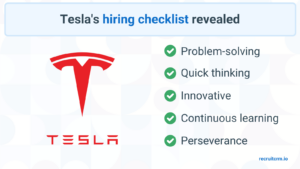
Here’s how Elon Musk achieves this hiring checklist:
a. Problem-solving:
Problem-solving, for Musk, is more about the journey than the destination. It’s how one navigates through complexities to arrive at a solution.
Musk’s “Two-Hands” method delves into this narrative.
If an individual truly steered a problem to its solution, they should be able to chronicle their thought process in depth.
It qualifies candidates through first-hand experience and through hands-on expertise testing.
This insight demonstrates the importance Musk places on skill-based hiring, quick thinking and innovation.
b. Continuous learning:
Elon Musk is always seen advocating for constant learning and adaptation and going beyond formal education.
Musk’s personal foray into rocket science, as documented in Ashley Vance’s biography “Elon Musk: Tesla, SpaceX, and the Quest for a Fantastic Future“, epitomizes his belief in self-learning.
Without a formal background, Musk consumed vast amounts of rocketry literature, eventually challenging seasoned aerospace professionals.
In the same way, he expects new hires to be lifelong learners, no matter what their educational background may be.
While academic qualifications can be indicative, they shouldn’t be definitive. Musk’s emphasis is on raw skill and genuine expertise.
Also read: 5 skills & strategies required by a recruiter in a post-pandemic world
8. Salesforce’s secret to building an exceptional team with internal recruiting!
Salesforce is doing something remarkable in the recruitment world. Using a strong internal recruiting program, they focus on growing their team from within.
How?
First off, Salesforce sees the value in its existing team members.
They have created a supportive space for employees to develop and move up within the company.
This keeps the best talent in-house, building a genuinely connected team to the company’s goals.
A big part of this strategy is promoting internal mobility.
Salesforce has set up systems that make it easy for employees to move to different roles within the company, aligning with their individual skills and interests.
This approach encourages people to grow in their careers without looking for opportunities elsewhere, promoting a positive and collaborative work culture.
One of the standout features of Salesforce’s approach is its open recruitment communication policy.
They ensure all employees have clear information about job opportunities within the company, encouraging everyone to steer their career in a direction that suits them best.
The company is committed to helping its team grow professionally by offering training and development programs and providing the resources needed for employees to excel in their roles.
You might also like: Recruiter certification 101: 10+ courses you can’t afford to miss!
There you have it.
Whether you’re a recruiter, candidate, or professional from any background, here’s your cheat sheet on how the best global companies bag the best talent!
Frequently asked questions
1. How can I develop a strong employer brand to attract top talent?
To build a strong employer brand, focus on showcasing your company’s values, culture, and opportunities through various platforms. Engage with your audience through social media and maintain a positive work environment, encouraging growth and development.
2. How can I foster a workplace culture similar to Google’s in my recruitment firm?
To cultivate a workplace culture akin to Google’s, encourage innovation and creativity among your team. Focus on providing opportunities for skill development and fostering an inclusive, collaborative, and transparent work environment where employees feel valued.
3. How can I implement a value-based hiring strategy?
Implementing a value-based hiring strategy involves aligning your recruitment process with your company’s core values.
Assess candidates for their skills and alignment with your organizational values, fostering a cohesive and harmonious work environment.




